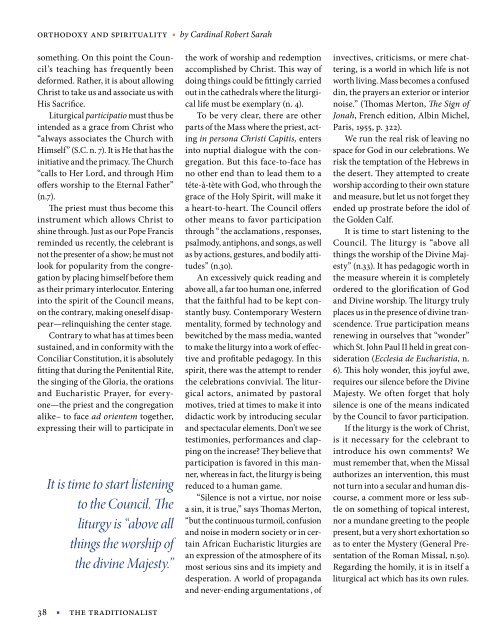You also want an ePaper? Increase the reach of your titles
YUMPU automatically turns print PDFs into web optimized ePapers that Google loves.
Orthodoxy and Spirituality ■ by Cardinal Robert Sarah<br />
something. On this point the Council’s<br />
teaching has frequently been<br />
deformed. Rather, it is about allowing<br />
Christ to take us and associate us with<br />
His Sacrifice.<br />
Liturgical participatio must thus be<br />
intended as a grace from Christ who<br />
“always associates the Church with<br />
Himself” (S.C. n. 7). It is He that has the<br />
initiative and the primacy. The Church<br />
“calls to Her Lord, and through Him<br />
offers worship to the Eternal Father”<br />
(n.7).<br />
The priest must thus become this<br />
instrument which allows Christ to<br />
shine through. Just as our Pope Francis<br />
reminded us recently, the celebrant is<br />
not the presenter of a show; he must not<br />
look for popularity from the congregation<br />
by placing himself before them<br />
as their primary interlocutor. Entering<br />
into the spirit of the Council means,<br />
on the contrary, making oneself disappear—relinquishing<br />
the center stage.<br />
Contrary to what has at times been<br />
sustained, and in conformity with the<br />
Conciliar Constitution, it is absolutely<br />
fitting that during the Penitential Rite,<br />
the singing of the Gloria, the orations<br />
and Eucharistic Prayer, for everyone—the<br />
priest and the congregation<br />
alike– to face ad orientem together,<br />
expressing their will to participate in<br />
It is time to start listening<br />
to the Council. The<br />
liturgy is “above all<br />
things the worship of<br />
the divine Majesty.”<br />
38 ■ the traditionalist<br />
the work of worship and redemption<br />
accomplished by Christ. This way of<br />
doing things could be fittingly carried<br />
out in the cathedrals where the liturgical<br />
life must be exemplary (n. 4).<br />
To be very clear, there are other<br />
parts of the Mass where the priest, acting<br />
in persona Christi Capitis, enters<br />
into nuptial dialogue with the congregation.<br />
But this face-to-face has<br />
no other end than to lead them to a<br />
téte-à-tète with God, who through the<br />
grace of the Holy Spirit, will make it<br />
a heart-to-heart. The Council offers<br />
other means to favor participation<br />
through “ the acclamations , responses,<br />
psalmody, antiphons, and songs, as well<br />
as by actions, gestures, and bodily attitudes”<br />
(n.30).<br />
An excessively quick reading and<br />
above all, a far too human one, inferred<br />
that the faithful had to be kept constantly<br />
busy. Contemporary Western<br />
mentality, formed by technology and<br />
bewitched by the mass media, wanted<br />
to make the liturgy into a work of effective<br />
and profitable pedagogy. In this<br />
spirit, there was the attempt to render<br />
the celebrations convivial. The liturgical<br />
actors, animated by pastoral<br />
motives, tried at times to make it into<br />
didactic work by introducing secular<br />
and spectacular elements. Don’t we see<br />
testimonies, performances and clapping<br />
on the increase? They believe that<br />
participation is favored in this manner,<br />
whereas in fact, the liturgy is being<br />
reduced to a human game.<br />
“Silence is not a virtue, nor noise<br />
a sin, it is true,” says Thomas Merton,<br />
“but the continuous turmoil, confusion<br />
and noise in modern society or in certain<br />
African Eucharistic liturgies are<br />
an expression of the atmosphere of its<br />
most serious sins and its impiety and<br />
desperation. A world of propaganda<br />
and never-ending argumentations , of<br />
invectives, criticisms, or mere chattering,<br />
is a world in which life is not<br />
worth living. Mass becomes a confused<br />
din, the prayers an exterior or interior<br />
noise.” (Thomas Merton, The Sign of<br />
Jonah, French edition, Albin Michel,<br />
Paris, 1955, p. 322).<br />
We run the real risk of leaving no<br />
space for God in our celebrations. We<br />
risk the temptation of the Hebrews in<br />
the desert. They attempted to create<br />
worship according to their own stature<br />
and measure, but let us not forget they<br />
ended up prostrate before the idol of<br />
the Golden Calf.<br />
It is time to start listening to the<br />
Council. The liturgy is “above all<br />
things the worship of the Divine Majesty”<br />
(n.33). It has pedagogic worth in<br />
the measure wherein it is completely<br />
ordered to the glorification of God<br />
and Divine worship. The liturgy truly<br />
places us in the presence of divine transcendence.<br />
True participation means<br />
renewing in ourselves that “wonder”<br />
which St. John Paul II held in great consideration<br />
(Ecclesia de Eucharistia, n.<br />
6). This holy wonder, this joyful awe,<br />
requires our silence before the Divine<br />
Majesty. We often forget that holy<br />
silence is one of the means indicated<br />
by the Council to favor participation.<br />
If the liturgy is the work of Christ,<br />
is it necessary for the celebrant to<br />
introduce his own comments? We<br />
must remember that, when the Missal<br />
authorizes an intervention, this must<br />
not turn into a secular and human discourse,<br />
a comment more or less subtle<br />
on something of topical interest,<br />
nor a mundane greeting to the people<br />
present, but a very short exhortation so<br />
as to enter the Mystery (General Presentation<br />
of the Roman Missal, n.50).<br />
Regarding the homily, it is in itself a<br />
liturgical act which has its own rules.


